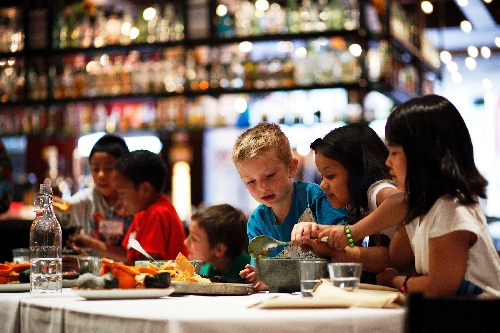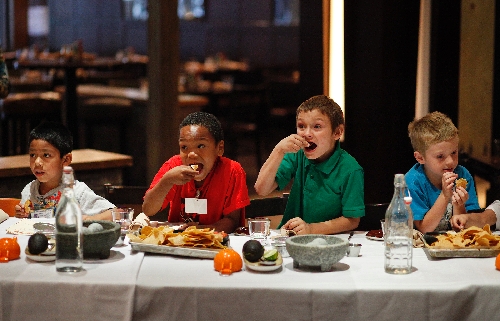Kids learning culinary arts as First Grade Food Critics




The students who were due to attend a cooking class at El Segundo Sol on the Strip were late. As restaurant employees and a few observers waited, they speculated aloud about whether the group had been delayed by an accident on the freeway. And then the group arrived, and leader Benjamin Brown explained that the delay was to avoid a different kind of accident – because when you’re 6 years old, sometimes you just can’t wait.
The 15 students were members of the First Grade Food Critics, founded by Brown, their teacher at Robert E. Lake Elementary School. They were there to eat and, yes, comment on the food, and also to learn to cook some of it.
El Segundo Sol offers monthly cooking classes, but usually the students are a lot taller, and usually they are offered beverages containing alcohol, so there were a couple of changes right off the bat. And restaurant chef Saul Garcia said the order would be reversed somewhat and they’d get right to the guacamole making, "because they’re kids."
Ah, yes. Fifteen first-graders were going to try their hand at making guacamole. That sounded like a recipe for something other than guacamole.
But as they took their seats at the long tables already set with chips and salsas, the noise and mischief levels were surprisingly low, maybe in part because one student had been left behind because of a discipline problem. ("The kids definitely got a lesson in behaving," Brown said.) There were a few questions – "Mr. B! Mr. B!" – including why they each had been given a pen.
"If you want to take notes," said Kori Zornes, catering sales manager.
At 23 and in his second year of teaching, Brown was nearly as enthusiastic as the kids, but it was clear who was in charge. As soon as he called "Trojans!" the noise level dropped even more. "Big thank you to Miss Kori," and then the news they were waiting for, "Miss Kori said we’re allowed to have the chips and salsa." So then it was crunch, crunch, but also an air of expectation, until Garcia stood before them. He explained the salsas and what each contained, and then they went to work. But no wishy-washy adjectives like "good" or "OK" for these little critics.
"It’s awesome!" one pronounced.
"Fantastic!" said another.
Each table contained a few molcajetes, the Mexican kin of a classic mortar and pestle. Molcajetes aren’t even familiar to many adults, and the young students had their own questions.
Kid: "What is that?"
Garcia: "This is called a molcajete."
Kid: "It’s heavy!"
Server Tiffany Lopez: "They’re supposed to be, to get the job done."
And Brown, holding up a pestle: "We are not touching this!" for a lesson in food safety.
With Garcia directing and the adults assisting, the kids emptied cups of chopped serrano pepper, onion and garlic into their molcajetes and sprinkled on some salt. Then Garcia began to demonstrate the process of juicing a lime, but Karyme Romero didn’t have to wait. She picked up the hand-held juicer, deftly popped in a lime half and positioned it over the molcajete, using both hands to expertly squeeze the juice.
"I’ve got a thing like this" at home, she explained. "And I’ve got another little one."
She and her two seatmates proceeded to mash the contents of the molcajete, at which point Garcia told them to add the tomato and cilantro. Then they added the avocado halves, using large spoons to help mix, mash and scrape, and – most importantly – "Then smash it again?"
"I was impressed with how they made guacamole," Garcia said later. "We’ve had kids before. These kids are much better."
Then it was quesadilla time, and volunteer Jasmine Amaya went to the cooking station and, with Garcia’s help, carefully sprinkled cheese over a tortilla, adding cilantro and corn and then another tortilla on top. As the scent of butter wafted through the air, Garcia flipped the quesadilla to reveal a nicely browned surface.
"Oooooo" from the peanut gallery.
Did Jasmine think she might try a quesadilla at home?
"Only if I have the stuff to make it," she said sagely.
They settled in to eat as chaperone Anna Redfern walked from lap to lap, distributing napkins. They returned to the cooking station for the demonstration of mango ice, then back to their seats for their own cups of ice and strawberries, which one – and then another, and then another – decided to stir up into a smoothie.
"This is what the chef made who was really tall," Karyme said, referring to a previous demonstration. "Remember?"
Jovanny Guzman had a question, clearly tied to another previous lesson.
"Mr. B, is this healthy?" he wanted to know.
Three little boys asked where the restroom was and headed off, followed by an increasing group, and Brown racing after them to keep order.
And then it was time to learn about the industry.
"How did you get to have such a cool job like being a chef?" Brown asked Garcia, who responded with a resume summary geared to a first-grade mind.
Brown said the program has an important career component.
"The kids have been exposed to a number of career outlets in the dining industry," he said. Lake, he said, is in a neighborhood familiar with economic disadvantages, where "the vast majority" of students qualify for free and reduced lunches.
"The families, many of them are maintenance staff, front-desk workers, sanitation workers," he said. "The kids are being exposed to jobs that the families wouldn’t otherwise be able to put them in touch with."
And he sees more immediate results of an educational nature.
"The kids expanded their vocabulary tenfold" through the two field trips and five class guests since the program started in March. "They’re aware of all of these adjectives, if you will, to define food and experiences they wouldn’t otherwise learn until the third or fourth grade."
Brown graduated from college as a broadcast journalist and was recruited by Teach for America, which he said recruits recent college graduates to become teachers in underprivileged areas.
"I knew I didn’t want to be a conventional journalist," Brown said, but he does food and travel writing for publications including the Las Vegas Food and Beverage Magazine and Examiner.com.
The seeds of First Grade Food Critics, he said, were planted in Panama last summer, where his assignments included teaching English at a rural elementary school.
"After seeing this setting, I realized how privileged the kids that I teach in Las Vegas really are," Brown said. "Even though they don’t come from the best financial backgrounds, in the U.S. we have so many resources available to us." He knew the program would "expose the kids to a whole different side of the city, as well as a plethora of career choices."
Next year, he’ll be teaching middle-school English. So, Sixth Grade Food Critics? Brown said he’s not sure what grade he’ll be teaching, but he hopes to re-create the program for the older kids, along with an interactive online element.
And he hasn’t given up on journalism, continuing to work as a food journalist. Eventually, he wants to start a media outlet in travel and food.
"The ability to have an impact on the community with kids, especially at this age, is something I didn’t want to pass up," he said. "I thought it was a great opportunity to make a difference in kids’ lives."
Contact reporter Heidi Knapp Rinella at hrinella@reviewjournal.com or 702-383-0474.


















